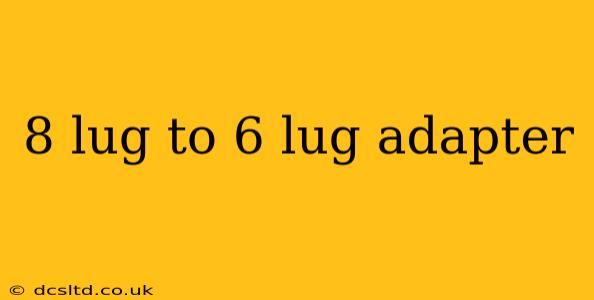Changing your vehicle's wheel setup can be a significant undertaking, and one popular modification involves using an 8 lug to 6 lug adapter. This allows you to switch from an 8-lug wheel pattern to a 6-lug pattern, opening up a wider range of wheel options. However, this modification is not without its risks and complexities. This guide delves into the intricacies of 8 lug to 6 lug adapters, providing you with the information you need to make an informed decision.
What is an 8 Lug to 6 Lug Wheel Adapter?
An 8 lug to 6 lug adapter is a precisely engineered piece of hardware that fits between your vehicle's wheel studs (the 8-lug pattern) and the new 6-lug wheels you want to install. Essentially, it acts as a translator, converting the bolt pattern. These adapters are typically made from high-strength materials like steel or aluminum to withstand the stresses of driving. They consist of two concentric rings: one with eight studs that match your vehicle's hub, and another with six holes to accept the 6-lug wheels.
Why Use an 8 Lug to 6 Lug Adapter?
Several reasons might prompt someone to use an 8 lug to 6 lug adapter:
- Increased Wheel Selection: 6-lug wheel patterns are significantly more common than 8-lug patterns, giving you access to a wider variety of styles, sizes, and brands.
- Cost Savings: 6-lug wheels often come at lower prices than their 8-lug counterparts.
- Specific Wheel Requirements: You might need a specific wheel design only available in a 6-lug configuration.
What are the Risks and Considerations of Using an 8 Lug to 6 Lug Adapter?
While offering expanded options, using adapters introduces several potential risks:
- Reduced Wheel Strength: Adding an adapter increases the distance between the wheel and the hub, potentially weakening the overall wheel assembly and increasing the risk of wheel failure.
- Increased Stress on Wheel Bearings and Studs: The added weight and leverage of the adapter puts extra strain on your vehicle's wheel bearings and studs, leading to premature wear and potential failure.
- Brake Clearance Issues: Adapters can sometimes interfere with brake calipers or other brake components, requiring modifications or specialized adapters.
- Proper Hubcentricity: Ensure the adapter is hub-centric (fits snugly onto the hub) to prevent vibrations and ensure safe operation. An improper fit can lead to dangerous wobbling.
- Legal Compliance: Check your local vehicle regulations, as using adapters might not always be legal or might require specific inspections.
How to Choose the Right 8 Lug to 6 Lug Adapter?
Selecting the right adapter is crucial for safety. Consider these factors:
- Material: Opt for high-quality materials like forged aluminum or high-strength steel.
- Thickness: Thinner adapters are preferable to minimize the added distance from the hub to the wheel.
- Bolt Pattern: Ensure precise matching of both the 8-lug and 6-lug patterns.
- Hub-centric Design: A hub-centric adapter will provide a much safer and more stable fit.
- Wheel Stud Length: The adapter should not interfere with the length of your wheel studs.
What are the Alternatives to Using Adapters?
If possible, explore alternatives to using adapters:
- Purchasing 8-Lug Wheels: This eliminates the risks associated with adapters but might limit your wheel choices.
- Wheel Modification: In some cases, you might be able to modify your existing wheels to fit your vehicle, but this often requires professional assistance.
Are 8 Lug to 6 Lug Adapters Legal?
Legality varies depending on location and specific regulations. Always check with your local Department of Motor Vehicles (DMV) or equivalent agency to ensure compliance. Using adapters might necessitate safety inspections or specific certifications.
How Much Do 8 Lug to 6 Lug Adapters Cost?
The cost of adapters varies based on material, size, quality, and brand. Expect to pay anywhere from a few hundred dollars to well over a thousand dollars for a high-quality set.
How Do I Install an 8 Lug to 6 Lug Adapter?
Installing wheel adapters requires mechanical skill and the proper tools. If you're unsure, it's best to leave the installation to a qualified professional. Incorrect installation can compromise safety and void any warranties.
This information is for educational purposes only. Always consult with a qualified mechanic or automotive professional before undertaking any modifications to your vehicle. Safety should be your paramount concern when working with your vehicle's suspension and wheels.
